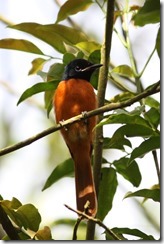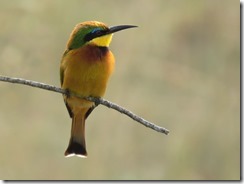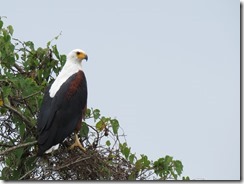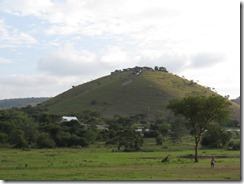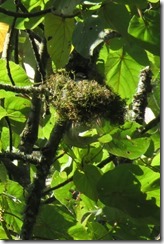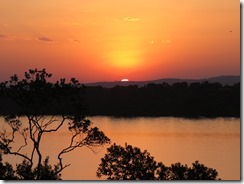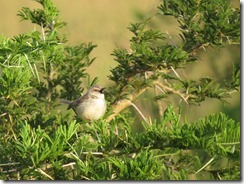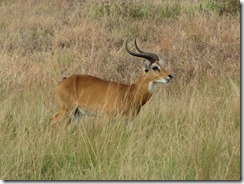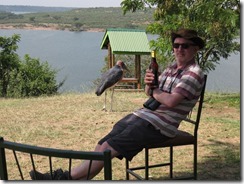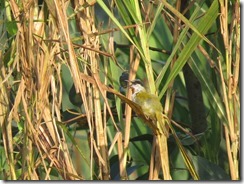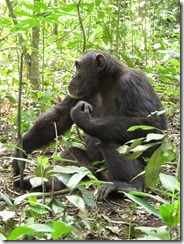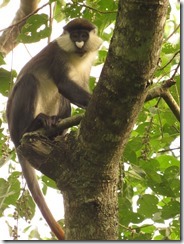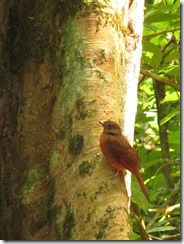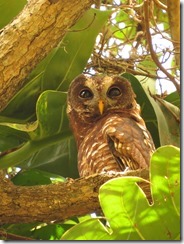 Early start as we headed for Mabamba Swamp, a couple of hours away. Birded on route and picked up a few bits including four new birds for me: Grey-headed Warbler, Black-and-White Shrike Flycatcher, Green-headed Sunbird, and White-headed Saw-wing.
Early start as we headed for Mabamba Swamp, a couple of hours away. Birded on route and picked up a few bits including four new birds for me: Grey-headed Warbler, Black-and-White Shrike Flycatcher, Green-headed Sunbird, and White-headed Saw-wing.
At the Swamp we picked up our guides and got on our two boats and headed off to where the Shoebills are found. They weren’t there. No panic, the guides went off to the other spot that they are presumably found in. They weren’t there either. So we headed off again and after about twenty minutes it dawned on me that we weren’t actually heading off to another known spot but just going up and down channels searching. I questioned Luke and he pretty much agreed that they always see them in one of the two spots we had been to but due to recent rain, the water was high and the birds had moved off. A couple of hours later (way past our allocated time) we were still searching. We were going to dip Shoebill! I don’t think the other birders realised, but if we failed here we went home empty handed. I began planning my return visit: A huge overnight taxi ride back to the swamp for a dawn visit before a mad dash to the airport. I didn’t fancy that, but didn’t fancy leaving Uganda without a Shoebill.
Then we got some news that one had been spotted. Both boats made a mad dash to the rough location. We then saw one fly distantly away. I hadn’t even seen it’s head and was told it may have been a Goliath Heron (though I think it was a Shoebill). Whatever, it was untickable. Disaster!
Then I spotted a boat watching something intently. I was told by someone on the other boat that they weren’t watching anything in particular and the now slightly worried guides spent the next five minutes discussing their plans. Howver, the other boat was still watching something intently. I climbed up on the back of the boat, balancing on the side and the engine, and the extra height enabled me to see what they were watching: I could see a Shoebill’s head!
We then attempted to make our way closer to it but the channel we were going down was pretty much un-navigable. Whenever we stopped I climbed back up and watched the bird and an ever decreasing range. I was still the only one to actually see the bird as nobody else seemed willing to do so. We eventually got reasonably close (though I still couldn’t see the whole bird) but then with the noise of dragging the boats along the channel, the bird was flushed. I’d had good enough views, including some good ones in flight, so the day (and trip!) was saved.
 After lunch we continued south towards Lake Mburu. We stopped only once at a wetland and arrived at our magnificent campsite on top of a hill shortly before dusk.
After lunch we continued south towards Lake Mburu. We stopped only once at a wetland and arrived at our magnificent campsite on top of a hill shortly before dusk.
Checklist

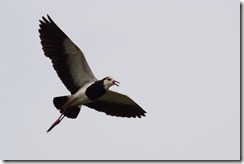
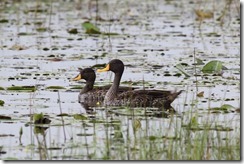
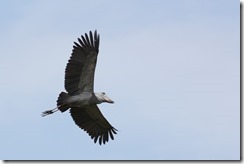
 Arrived in Entebbe and the first bird seen was a Long-crested Eagle from inside the plane. Met by taxi driver and taken to lodge. Freshened up, birded the garden for a bit, and chatted with my five companions who had arrived over the previous day or so.
Arrived in Entebbe and the first bird seen was a Long-crested Eagle from inside the plane. Met by taxi driver and taken to lodge. Freshened up, birded the garden for a bit, and chatted with my five companions who had arrived over the previous day or so.  Obvious highlight was Ross’s Turaco. but other new birds included Black-and-White Casqued Hornbill, Red-chested Sunbird, and a few Weaver species, including a single Orange Weaver, the only one of the trip.
Obvious highlight was Ross’s Turaco. but other new birds included Black-and-White Casqued Hornbill, Red-chested Sunbird, and a few Weaver species, including a single Orange Weaver, the only one of the trip.